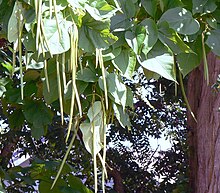Catalpa
| Catalpa | |
|---|---|

| |
| Catalpa speciosa flowers, leaf and bark | |
| Scientific classification | |
| Kingdom: | Plantae |
| Clade: | Tracheophytes |
| Clade: | Angiosperms |
| Clade: | Eudicots |
| Clade: | Asterids |
| Order: | Lamiales |
| Family: | Bignoniaceae |
| Tribe: | |
| Genus: | Catalpa Scopoli |
| Species | |

Catalpa, commonly called catalpa or catawba, is a genus of flowering plants in the family Bignoniaceae, native to warm temperate and subtropical regions of North America, the Caribbean, and East Asia.
Description[]
Most Catalpa are deciduous trees; they typically grow to 12–18 metres (40–60 ft) tall, with branches spreading to a diameter of about 6–12 metres (20–40 ft). They are fast growers and a 10-year-old sapling may stand about 6 metres (20 ft) tall. They have characteristic large, heart-shaped leaves, which in some species are three-lobed. The appearance of the leaves sometimes causes confusion with species such as the unrelated tung tree (Vernicia fordii) and Paulownia tomentosa. Catalpa species bear broad panicles of showy flowers, generally in summer. The flower colour generally is white to yellow. In late summer or autumn the fruit appear; they are siliques about 20–50 centimetres (8–20 in) long, full of small flat seeds, each with two thin wings to aid in wind dispersal.
The large leaves and dense foliage of Catalpa species provide good shelter from rain and wind, making the trees an attractive habitat for many species of birds. They do not present many threats of falling limbs, but the dark-brown fruit husks that they drop in late summer may be a nuisance.
Though Catalpa wood is quite soft, it is popular for turning and for furniture when well seasoned, being attractive, stable and easy to work.[1]
Most catalpas begin flowering after roughly three years, and produce fruit after about five years,[citation needed] although Haitian catalpa (Catalpa longissima) can flower after six months growth from seed and produce seed after 18 months.[2]
Species[]
The two North American species, Catalpa bignonioides (southern catalpa) and Catalpa speciosa (northern catalpa), have been widely planted outside their natural ranges as ornamental trees for their showy flowers and attractive shape. Northern and southern catalpas are very similar in appearance, but the northern species has slightly larger leaves, flowers, and bean pods. Flowering starts after 275 growing degree days. Catalpa ovata from China, with pale yellow flowers, is also planted outside its natural range for ornamental purposes. This allowed C. bignonioides and C. ovata to hybridize, with the resultant Catalpa × erubescens also becoming a cultivated ornamental.
List of selected species[]
Sources:(GRIN accepts 8 species)[3](KEW accepts 8 species)[4](IPNI accepts 52 species)[5]
- Catalpa bignonioides Walter – southern catalpa
- Catalpa brevipes Urb.
- Catalpa bungei C.A.Mey. – Manchurian catalpa
- Spreng.
- Dum.Cours.
- Moench
- Urb.
- Urb.
- Dode
- Urb.
- Catalpa fargesii Bureau
- Dode
- Dode
- Hort. ex Dippel
- Spreng.
- Siebold & Zucc.
- Cham.
- (Jacq.) Dum.Cours. – Haitian catalpa
- Ekman
- Spreng.
- Hort. ex Dippel
- Urb. & Ekman
- Urb.
- Catalpa ovata G.Don – Chinese catalpa, yellow catalpa
- Seem.
- (Griseb.) Bisse
- Hort. ex Wien.
- Griseb.
- Griseb.
- (Pamp. & Bonati) S.Y.Hu
- Catalpa speciosa Warder ex Engelm. – northern catalpa
- Dode
- Cav.
- Hort. ex Wien.
- Forrest
- Hort.
- Diels
- Hort. ex Wien.
Etymology[]
The name derives from the Muscogee name for the tree, "kutuhlpa" meaning "winged head" and is unrelated to the name of the Catawba people.[6][7] The spellings "Catalpa" and "Catalpah" were used by Mark Catesby between 1729 and 1732, and Carl Linnaeus published the tree's name as Bignonia catalpa in 1753.[8][9] Giovanni Antonio Scopoli established the genus Catalpa in 1777.
The bean-like seed pod is the origin of the alternative vernacular names Indian bean tree and cigar tree for Catalpa bignonioides and Catalpa speciosa, respectively.
Food source[]
The tree is the sole source of food for the catalpa sphinx moth (Ceratomia catalpae), the leaves being eaten by the caterpillars. When caterpillars are numerous, infested trees may be completely defoliated. Defoliated catalpas produce new leaves readily, but with multiple generations occurring, new foliage may be consumed by subsequent broods. Severe defoliation over several consecutive years can cause death of trees. Because the caterpillars are an excellent live bait for fishing, some dedicated anglers plant catalpa mini-orchards for their own private source of "catawba-worms", particularly in the southern states.[10]

Other uses[]
Catalpa is also occasionally used as a tonewood in guitars.
References[]
- ^ Maroni, Kristi; Sarah Domville (2003-12-04). "Catalpa Tree". Tree Walk. Nazareth College of Rochester. Archived from the original on 2008-12-10. Retrieved 2009-04-30.
- ^ F. T. Bonner The Woody Plant Seed Manual, p. 345, at Google Books
- ^ "Species Records of Catalpa". Agricultural Research Service (ARS), National Genetic Resources Program, Germplasm Resources Information Network (GRIN). USDA. Retrieved 12 April 2021.
- ^ "Catalpa Scop. | Plants of the World Online | Kew Science". Plants of the World Online. Retrieved 12 April 2021.
- ^ "Plant name details for Catalpa". International Plant Names Index (IPNI). Retrieved 12 April 2021.
- ^ Gerard, William R. Plant names of Indian origin_II. Garden and Forest. volume 9, no. 436. page 262. (1896).[1]
- ^ Cassidy, Fred. Lemmatization—The case of "Catalpa". in McIntosh, Language Form and Linguistic Variation: Papers Dedicated to Angus McIntosh. Amsterdam : Benjamins, 1982. Current issues in linguistic theory, 15.
- ^ Catesby, Mark.The natural history of Carolina, Florida and the Bahama Islands. volume 1. page and plate 49. [2]
- ^ Linne, Carolus von Linne. Species Plantarum. 1st edition. 1753. volume 2. page 622 [3]
- ^ Hyche, L. L., "The Catalpa Sphinx" Department of Entomology Auburn University, http://www.ag.auburn.edu/enpl/bulletins/catalpasphinx/catalpasphinx.htm Retrieved on 2009, 05-16.
External links[]
| Wikimedia Commons has media related to Catalpa. |
- Catalpa
- Bignoniaceae genera